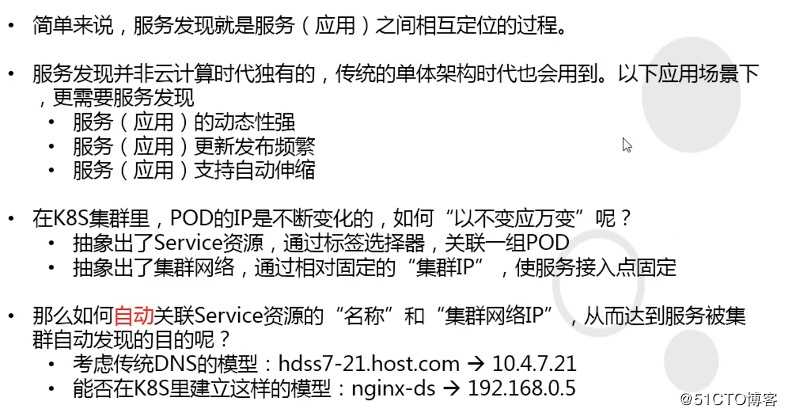K8S 之 Coredns安装与理解
Posted
tags:
篇首语:本文由小常识网(cha138.com)小编为大家整理,主要介绍了K8S 之 Coredns安装与理解相关的知识,希望对你有一定的参考价值。
一、Coredns作用

重点:通过coredns 通过service名称,解释到相应的cluter集群IP
二、Coredns安装(以容器搭建服务)
1、在运维主机上搭建一个HTTP服务存放yaml文件
~]# cd /etc/nginx/conf.d/
conf.d]# vi /etc/nginx/conf.d/k8s-yaml.od.com.conf
server {
listen 80;
server_name k8s-yaml.od.com;
location / {
autoindex on;
default_type text/plain;
root /data/k8s-yaml;
}
}
conf.d]# mkdir /data/k8s-yaml
conf.d]# nginx -t
conf.d]# nginx -s reload
conf.d]# cd /data/k8s-yaml/
k8s-yaml]# mkdir coredns
2、创建四个yaml文件,用于coredns容器创建
[root@test-operator coredns]# cat rbac.yaml
apiVersion: v1
kind: ServiceAccount
metadata:
name: coredns
namespace: kube-system
labels:
kubernetes.io/cluster-service: "true"
addonmanager.kubernetes.io/mode: Reconcile
---
apiVersion: rbac.authorization.k8s.io/v1
kind: ClusterRole
metadata:
labels:
kubernetes.io/bootstrapping: rbac-defaults
addonmanager.kubernetes.io/mode: Reconcile
name: system:coredns
rules:
- apiGroups:
- ""
resources:
- endpoints
- services
- pods
- namespaces
verbs:
- list
- watch
---
apiVersion: rbac.authorization.k8s.io/v1
kind: ClusterRoleBinding
metadata:
annotations:
rbac.authorization.kubernetes.io/autoupdate: "true"
labels:
kubernetes.io/bootstrapping: rbac-defaults
addonmanager.kubernetes.io/mode: EnsureExists
name: system:coredns
roleRef:
apiGroup: rbac.authorization.k8s.io
kind: ClusterRole
name: system:coredns
subjects:
- kind: ServiceAccount
name: coredns
namespace: kube-system
-----------------------------------------------------------------------------------------------
[root@test-operator coredns]# cat cm.yaml
apiVersion: v1
kind: ConfigMap
metadata:
name: coredns
namespace: kube-system
data:
Corefile: |
.:53 {
errors
log
health
ready
kubernetes cluster.local 192.168.0.0/16
forward . 10.3.151.13
cache 30
loop
reload
loadbalance
}
-----------------------------------------------------------------------------------------------
[root@test-operator coredns]# cat dp.yaml
apiVersion: apps/v1
kind: Deployment
metadata:
name: coredns
namespace: kube-system
labels:
k8s-app: coredns
kubernetes.io/name: "CoreDNS"
spec:
replicas: 1
selector:
matchLabels:
k8s-app: coredns
template:
metadata:
labels:
k8s-app: coredns
spec:
priorityClassName: system-cluster-critical
serviceAccountName: coredns
containers:
- name: coredns
image: test-harbor.cedarhd.com/public/coredns:v1.6.1
args:
- -conf
- /etc/coredns/Corefile
volumeMounts:
- name: config-volume
mountPath: /etc/coredns
ports:
- containerPort: 53
name: dns
protocol: UDP
- containerPort: 53
name: dns-tcp
protocol: TCP
- containerPort: 9153
name: metrics
protocol: TCP
livenessProbe:
httpGet:
path: /health
port: 8080
scheme: HTTP
initialDelaySeconds: 60
timeoutSeconds: 5
successThreshold: 1
failureThreshold: 5
dnsPolicy: Default
volumes:
- name: config-volume
configMap:
name: coredns
items:
- key: Corefile
path: Corefile
-----------------------------------------------------------------------------------------------
[root@test-operator coredns]# cat svc.yaml
apiVersion: v1
kind: Service
metadata:
name: coredns
namespace: kube-system
labels:
k8s-app: coredns
kubernetes.io/cluster-service: "true"
kubernetes.io/name: "CoreDNS"
spec:
selector:
k8s-app: coredns
clusterIP: 192.168.0.2
ports:
- name: dns
port: 53
protocol: UDP
- name: dns-tcp
port: 53
- name: metrics
port: 9153
protocol: TCP
3、在其中一个节点服务器运行coredns(安装成功)
[root@test-nodes1 ~]# kubectl apply -f http://k8s-yaml.cedarhd.com/coredns/rbac.yaml
serviceaccount/coredns created
clusterrole.rbac.authorization.k8s.io/system:coredns created
clusterrolebinding.rbac.authorization.k8s.io/system:coredns created
[root@test-nodes1 ~]# kubectl apply -f http://k8s-yaml.cedarhd.com/coredns/cm.yaml
configmap/coredns created
[root@test-nodes1 ~]# kubectl apply -f http://k8s-yaml.cedarhd.com/coredns/dp.yaml
deployment.apps/coredns created
[root@test-nodes1 ~]# kubectl apply -f http://k8s-yaml.cedarhd.com/coredns/svc.yaml
service/coredns created
[root@test-nodes1 ~]# kubectl get all -n kube-system
NAME READY STATUS RESTARTS AGE
pod/coredns-6c69fbcc6c-6vqgr 1/1 Running 0 35s
NAME TYPE CLUSTER-IP EXTERNAL-IP PORT(S) AGE
service/coredns ClusterIP 192.168.0.2 <none> 53/UDP,53/TCP,9153/TCP 14s
NAME READY UP-TO-DATE AVAILABLE AGE
deployment.apps/coredns 1/1 1 1 36s
NAME DESIRED CURRENT READY AGE
replicaset.apps/coredns-6c69fbcc6c 1 1 1 36s三、使用场景描述
1、创建一个新的svc资源
[root@test-nodes1 ~]# kubectl create deployment nginx-test --image=test-harbor.cedarhd.com/public/nginx:v1.7.9
deployment.apps/nginx-test created
[root@test-nodes1 ~]# kubectl get all
NAME READY STATUS RESTARTS AGE
pod/nginx-test-5674474869-c4mzx 1/1 Running 0 5s
NAME TYPE CLUSTER-IP EXTERNAL-IP PORT(S) AGE
service/kubernetes ClusterIP 192.168.0.1 <none> 443/TCP 8h
NAME READY UP-TO-DATE AVAILABLE AGE
deployment.apps/nginx-test 1/1 1 1 5s
NAME DESIRED CURRENT READY AGE
replicaset.apps/nginx-test-5674474869 1 1 1 5s
[root@test-nodes1 ~]# kubectl expose deployment nginx-test --port=80
service/nginx-test exposed
[root@test-nodes1 ~]# kubectl get all
NAME READY STATUS RESTARTS AGE
pod/nginx-test-5674474869-c4mzx 1/1 Running 0 42s
NAME TYPE CLUSTER-IP EXTERNAL-IP PORT(S) AGE
service/kubernetes ClusterIP 192.168.0.1 <none> 443/TCP 8h
service/nginx-test ClusterIP 192.168.109.13 <none> 80/TCP 8s
#创建svc为nginx-test 对应的cluterip为192.168.109.13
NAME READY UP-TO-DATE AVAILABLE AGE
deployment.apps/nginx-test 1/1 1 1 42s
NAME DESIRED CURRENT READY AGE
replicaset.apps/nginx-test-5674474869 1 1 1 42s
2、进入其中一个容器查看解释效果
[root@test-nodes2 ~]# kubectl get pods -n kube-public
NAME READY STATUS RESTARTS AGE
nginx-ds-dk9hf 1/1 Running 0 3h43m
nginx-ds-m6v9q 1/1 Running 0 3h43m
[root@test-nodes2 ~]# kubectl exec -ti nginx-ds-dk9hf /bin/bash -n kube-public
PING nginx-test.default.svc.cluster.local (192.168.109.13) 56(84) bytes of data.
64 bytes from nginx-test.default.svc.cluster.local (192.168.109.13): icmp_seq=1 ttl=64 time=0.070 ms
64 bytes from nginx-test.default.svc.cluster.local (192.168.109.13): icmp_seq=2 ttl=64 time=0.077 ms
#nginx-test.default defalut(容器所在的空间,必须加)以上是关于K8S 之 Coredns安装与理解的主要内容,如果未能解决你的问题,请参考以下文章